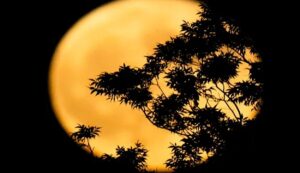Harvest Super Moon: Tonight the world will see a partial lunar eclipse along with a full Super Harvest Moon
The globe will be treated to a partial lunar eclipse on September 17, 2024, the same night as the full Super Harvest Moon. Many parts of the world, including North and South America, Europe, Africa, and parts of Asia, will be able to see this celestial spectacle. The planet Saturn, which will be visible in the area, is another noteworthy aspect of the event that will enhance its splendor.

When the moon moves into the penumbral shadow—Earth’s outer shadow—the eclipse will officially start. The partial lunar eclipse will then occur when 8.4% of the moon’s surface passes into the Earth’s darker umbral shadow. The most spectacular phase, when a portion of the moon is entirely covered, will continue for 63 minutes out of an estimated 4 hours and 6 minutes.
The partial lunar eclipse is scheduled to start at 8:41 p.m. Eastern Daylight Time and end at 10:44 p.m., when over 8% of the moon will be completely covered in shadow, according to NASA. The moon will be gradually fading as Earth’s shadow passes over it, making this the most visually arresting aspect of the event.
Exact Times for American Audiences
The eclipse will proceed as follows for those who are in the United States:
• In terms of Eastern Daylight Time (EDT), the partial eclipse will begin at 10:12 p.m. and the penumbral eclipse will begin at 8:41 p.m. At 10:44 p.m., there will be the biggest eclipse, and at 11:15 p.m., there will be a partial eclipse. On September 18, the penumbral eclipse will end at 12:47 a.m.
• Central Daylight Time (CDT): At 7:41 p.m., the penumbral eclipse starts, and at 9:12 p.m., the partial eclipse begins, peaking at 9:44 p.m. The event will end at around 10:15 p.m.
• Mountain Daylight Time (MDT) and Mountain Standard Time (MST): At moonrise, the penumbral eclipse will begin, and at 8:12 p.m. MDT, the partial eclipse will commence. The time of peak will be 8:44 p.m.
• Pacific Daylight Time (PDT): The eclipse will be visible to west coast viewers beginning at moonrise on June 55. The partial eclipse will commence at 7:12 p.m. and reach its zenith at 7:44 p.m.
With the help of this timetable, spectators may schedule their observation and take advantage of the finest viewing angles, weather permitting.
An Odd Eclipse
When the moon is completely covered in Earth’s shadow and turns crimson, it is known as a “blood moon,” although this partial eclipse is not quite as striking. Still, the phenomena is a stunning sight, especially when seen in conjunction with the Harvest Moon. Astronomer Jamie Carter observed that “it is one of the strangest sights in astronomy to see the side of Earth’s shadow projected onto the lunar surface.”
Only during the full moon phase, when the moon is exactly opposite the sun, completely lighted, and behind the Earth, can lunar eclipses like this one happen. The September full moon, which is sometimes referred to as the “Harvest Moon,” will in this instance give the occasion even more importance.
The Harvest Moon and Supermoon Described
The September full moon is referred to as the “Harvest Moon” as it occurs around the time when Northern Hemisphere crops are harvested. Farmers have historically benefited from more light under this moon by working through the night. The titles “Corn Moon” and “Barley Moon,” which date back centuries, are also used to refer to the Harvest Moon and emphasize its significance during the harvest season.
This full moon is also a “supermoon,” which happens when the moon is getting close to perigee, when it comes closest to Earth. The moon will look bigger and brighter than normal as a consequence. The moon’s eccentric orbit around the Earth causes supermoons. The full moon in August 2024, dubbed the “Sturgeon Moon,” was the biggest supermoon of the year. This month’s event is both a supermoon and the Harvest Moon, in contrast to the supermoon in August.
The eclipse will peak only ten minutes after the moon officially reaches fullness at 10:35 p.m. EDT, according to NASA’s confirmation.
upcoming celestial events
This moon eclipse is followed by another fascinating occurrence for anyone interested in further astronomical oddities. An annular solar eclipse known as the “ring of fire” will be seen from Easter Island and other areas of Chile and Argentina on October 2, 2024. After that, on March 14, 2025, there will be a complete lunar eclipse that may be seen across the United States.
Furthermore, on March 29, 2025, a partial solar eclipse will take place and be visible at dawn from a number of northeastern U.S. states. These occasions usher in a number of thrilling chances for skywatchers to see extraordinary celestial displays.
Conditions of the Weather for Observation
Whether or not observers can enjoy the lunar eclipse will depend greatly on the weather. Meteorologists predict cloud cover over the U.S. East Coast and in the Pacific Northwest during the event. There may be sporadic views in cities like Philadelphia, Cleveland, and Washington, D.C., but the Midwest and South should see better sky. Conditions for watching the eclipse are predicted to be ideal in Los Angeles, Phoenix, and the southern Plains.
October’s Next Full Moon
The “Hunter’s Moon,” or the next full moon, is scheduled for October 17, 2024. Historically, this moon has been connected to hunting and getting ready for winter. On that day, it will peak at 7:26 a.m. EDT.
On September 17, there will be a rare chance to see a special fusion of astronomical phenomena during the moon eclipse. It is recommended that skywatchers be ready for the Super Harvest Moon and partial lunar eclipse extravaganza.
Make sure you select a clear spot and check the weather before heading out for a celestial wonder night.




